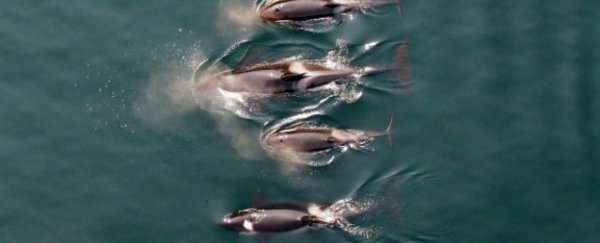In an attempt to find out more about the mysterious habits of killer whales, researchers enlisted the help of a hexacopter. The result is some spectacular footage.
Scientists from the Marine Mammal Research Program at the Vancouver Aquarium in Canada, and the US's National Oceanic and Atmospheric Administration have used an unmanned aerial vehicle (UAV) to monitor killer whale populations for the first time, and the footage has revealed fascinating insight into the health and habits of the species.
Their custom-made hexacopter - a six-blade, remote-controlled mini helicopter - which they named "Mobly" began monitoring whales in the waters of British Columbia's Johnstone Straight in August with its attached video camera, and within just two weeks had captured high quality images of more than 80 killer whales.
Scientists had previously monitored killer whale populations with helicopters, and have shown that you can tell which whales are malnourished and unlikely to recover, and which are pregnant, from the air.
But as Robbie Gonzalez explains for io9:
"Helicopters are noisy and disruptive to the whales. Even if a research team could afford one (helicopters are expensive – and we all know how filthy rich scientists are), the helicopter would have to be operated high above the water, making it it difficult to acquire quality images of the whales."
Mobly, on the other hand, is quieter than helicopters and can get in close enough to take high quality images that enable scientists to identify individual whales and monitor their conditions. This means the footage can be used to find out more about the health of killer whale populations and to also reveal the natural habits of the beautiful creatures.
In a blog entry, one of the project leaders Lance Barrett-Lennard, from the Vancouver Aquarium, writes:
"Mobly performed like a dream - steady, stable, and quiet. The images of the whales were stunning, and revealed right away that we weren't going to have difficulty distinguishing robust and thin whales. We could readily identify individuals based on scratches and scars on theirs saddle patches, which were easier to see from above than I expected, and we could positively identify pregnant females. Most importantly, the whales didn't react to Mobly visibly; not only did they not appear disturbed, they didn't seem to notice him at all."
This technology isn't only useful for monitoring whale populations - there are hundreds of species that we still know very little about that could benefit from some drone-monitoring.
Find out more about the project over at the Vancouver Aquarium's AquaBlog and in io9's article on the research.
Source: io9, Vancouver Aquarium
